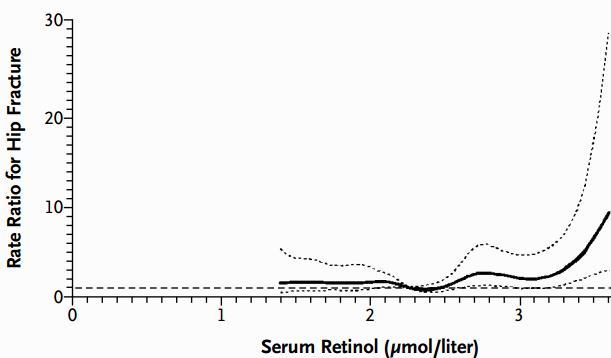7 X more likely to get hip fracture if have highest level of vitamin A
Serum retinol levels and the risk of fracture.
N Engl J Med. 2003 Jan 23;348(4):287-94.
Michaëlsson K, Lithell H, Vessby B, Melhus H.
Department of Surgical Sciences, Section of Orthopedics, University Hospital, Uppsala, Sweden. karl.michaelsson@surgsci.uu.se
BACKGROUND: Although studies in animals and epidemiologic studies have indicated that a high vitamin A intake is associated with increased bone fragility, no biologic marker of vitamin A status has thus far been used to assess the risk of fractures in humans.
METHODS: We enrolled 2322 men, 49 to 51 years of age, in a population-based, longitudinal cohort study. Serum retinol and beta carotene were analyzed in samples obtained at enrollment. Fractures were documented in 266 men during 30 years of follow-up. Cox regression analysis was used to determine the risk of fracture according to the serum retinol level.
RESULTS: The risk of fracture was highest among men with the highest levels of serum retinol. Multivariate analysis of the risk of fracture in the highest quintile for serum retinol (>75.62 microg per deciliter [2.64 micromol per liter]) as compared with the middle quintile (62.16 to 67.60 microg per deciliter [2.17 to 2.36 micromol per liter]) showed that the rate ratio was 1.64 (95 percent confidence interval, 1.12 to 2.41) for any fracture and 2.47 (95 percent confidence interval, 1.15 to 5.28) for hip fracture. The risk of fracture was further increased within the highest quintile for serum retinol. Men with retinol levels in the 99th percentile (>103.12 microg per deciliter [3.60 micromol per liter]) had an overall risk of fracture that exceeded the risk among men with lower levels by a factor of seven (P<0.001). The level of serum beta carotene was not associated with the risk of fracture.
CONCLUSIONS: Our findings, which are consistent with the results of studies in animals, as well as in vitro and epidemiologic dietary studies, suggest that current levels of vitamin A supplementation and food fortification in many Western countries may need to be reassessed.
Copyright 2003 Massachusetts Medical Society
Comment in
Hypervitaminosis A and fractures. [N Engl J Med. 2003]
Serum retinol levels and fracture risk. [N Engl J Med. 2003]
Serum retinol levels and fracture risk. [N Engl J Med. 2003]

PDF is attached at the bottom of this page
See also VitaminDWiki
Vitamin A serum levels of more than 2.2 micromols may interfere with vitamin D – April 2013
8X higher Osteoporosis risk if high level of vitamin A, vitamin D important too – Feb 2013
Vitamin A and dioxin-like compounds in fish liver, etc may block vitamin D – July 2012
Vitamin A Misc 200,000 IU of vitamin A twice a year to many kids around the world))
Response to high dose vitamin D is limited by vitamin A - July 2013
See also web
- High-dose treatment with vitamin A analogues and risk of fractures May 2010
- Risk of fracture is not associated with vitamin A analogue treatment
- Vitamin A and retinol intakes and the risk of fractures among participants of the Women's Health Initiative Observational Study Jan 2009
- No association between vitamin A or retinol intake and the risk of hip or total fractures was observed in postmenopausal women full text online
